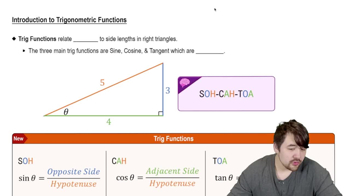Table of contents
- 0. Functions7h 52m
- Introduction to Functions16m
- Piecewise Functions10m
- Properties of Functions9m
- Common Functions1h 8m
- Transformations5m
- Combining Functions27m
- Exponent rules32m
- Exponential Functions28m
- Logarithmic Functions24m
- Properties of Logarithms34m
- Exponential & Logarithmic Equations35m
- Introduction to Trigonometric Functions38m
- Graphs of Trigonometric Functions44m
- Trigonometric Identities47m
- Inverse Trigonometric Functions48m
- 1. Limits and Continuity2h 2m
- 2. Intro to Derivatives1h 33m
- 3. Techniques of Differentiation3h 18m
- 4. Applications of Derivatives2h 38m
- 5. Graphical Applications of Derivatives6h 2m
- 6. Derivatives of Inverse, Exponential, & Logarithmic Functions2h 37m
- 7. Antiderivatives & Indefinite Integrals1h 26m
- 8. Definite Integrals4h 44m
- 9. Graphical Applications of Integrals2h 27m
- 10. Physics Applications of Integrals 2h 22m
1. Limits and Continuity
Finding Limits Algebraically
Problem 58
Textbook Question
Evaluate each limit.
lim x→0+ 1−cos^2x / sin x
 Verified step by step guidance
Verified step by step guidance1
Step 1: Recognize that the expression \(1 - \cos^2 x\) can be rewritten using the Pythagorean identity \(\sin^2 x + \cos^2 x = 1\). Therefore, \(1 - \cos^2 x = \sin^2 x\).
Step 2: Substitute \(\sin^2 x\) for \(1 - \cos^2 x\) in the limit expression. The limit now becomes \(\lim_{{x \to 0^+}} \frac{\sin^2 x}{\sin x}\).
Step 3: Simplify the expression \(\frac{\sin^2 x}{\sin x}\) by canceling one \(\sin x\) from the numerator and the denominator. This simplifies to \(\sin x\).
Step 4: Evaluate the limit \(\lim_{{x \to 0^+}} \sin x\). Since \(\sin x\) is continuous at \(x = 0\), you can directly substitute \(x = 0\) into \(\sin x\).
Step 5: Conclude the evaluation by noting that the limit of \(\sin x\) as \(x\) approaches 0 from the positive side is simply \(\sin(0)\).
 Verified video answer for a similar problem:
Verified video answer for a similar problem:This video solution was recommended by our tutors as helpful for the problem above
Video duration:
3mPlay a video:
Was this helpful?
Key Concepts
Here are the essential concepts you must grasp in order to answer the question correctly.
Limits
A limit is a fundamental concept in calculus that describes the behavior of a function as its input approaches a certain value. In this case, we are interested in the limit of the expression as x approaches 0 from the positive side (0+). Understanding limits is crucial for evaluating functions that may not be directly computable at specific points.
Recommended video:

One-Sided Limits
Trigonometric Functions
Trigonometric functions, such as sine and cosine, are periodic functions that relate angles to ratios of sides in right triangles. In the given limit, we encounter cos^2(x) and sin(x), which require knowledge of their properties and behaviors, especially near critical points like x = 0, where they can exhibit specific limits and values.
Recommended video:

Introduction to Trigonometric Functions
L'Hôpital's Rule
L'Hôpital's Rule is a method used to evaluate limits that result in indeterminate forms, such as 0/0 or ∞/∞. It states that if the limit of f(x)/g(x) leads to an indeterminate form, the limit can be found by taking the derivative of the numerator and the derivative of the denominator. This rule is particularly useful in simplifying complex limit problems involving trigonometric functions.
Recommended video:
Guided course

Power Rules

 5:21m
5:21mWatch next
Master Finding Limits by Direct Substitution with a bite sized video explanation from Callie
Start learningRelated Videos
Related Practice







